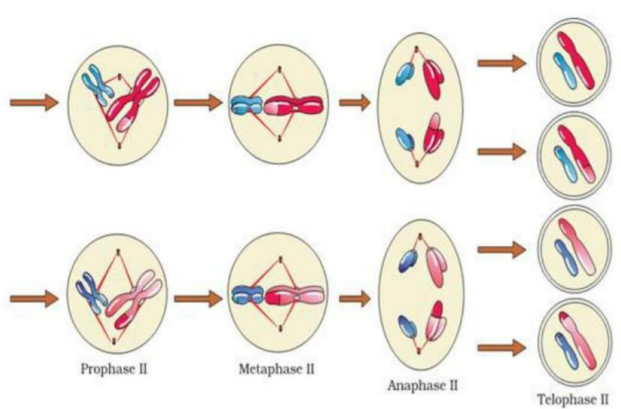Cell Cycle and Cell Division Class 11 important questions with answers PDF download
FAQs on CBSE Important Questions for Class 11 Biology Cell Cycle and Cell Division - 2025-26
1. What are the most important 5-mark questions from the topic Cell Cycle and Division for Class 11 CBSE 2025–26 exams?
- Phases of meiosis II with detailed description
- Explain mitosis and its stages in an animal cell
- Compare and contrast mitosis and meiosis, listing at least six differences
- Describe the regulation and significance of cell cycle checkpoints
- Discuss the significance of meiosis in maintaining chromosome number and genetic variation, with examples
2. Which cell cycle and division questions are frequently asked for 3 marks in Class 11 Biology board exams?
- Significance of meiosis in living organisms
- Distinguish between plant cell mitosis and animal cell mitosis
- Write the major differences between metaphase of mitosis and metaphase I of meiosis
- Explain what happens to homologous chromosomes during meiosis
- Calculate DNA content at G1, S, and G2 phases if the M phase content is given
3. What is a commonly misunderstood concept about the Go phase in the cell cycle for Class 11 students?
The Go phase is often confused as a passive state where nothing happens. In reality, cells in Go are metabolically active but do not proliferate. Cells can remain in Go temporarily or permanently, depending on their type and function.
4. How can I identify high-weightage areas within the Cell Cycle and Division chapter for CBSE Class 11 exams?
- Focus on phases and events of mitosis and meiosis (mechanisms, diagrams, and differences)
- Cell cycle regulation and checkpoints (conceptual short answer and HOTS)
- Process and significance of crossing over during meiosis
- Comparison tables: mitosis vs. meiosis, animal vs. plant cell mitosis
- Short factuals: Go phase, interphase events, chromosome terminology
5. Why is meiosis considered reductional division and what exam mistakes do students commonly make here?
Meiosis is called reductional division because it halves the chromosome number, producing haploid cells from diploid parents. Students often mistake this for mitosis, or incorrectly state that reduction occurs in both divisions of meiosis rather than specifically in meiosis I.
6. What type of conceptual application questions are likely in Cell Cycle and Division important questions for Class 11?
CBSE papers now include HOTS such as: describe what would happen if checkpoint mechanisms fail; predict the effect of a non-functional spindle apparatus; analyze DNA content changes during various cell cycle phases; or infer outcomes if crossing over is inhibited during meiosis.
7. How can questions on chromatin and chromatid be framed for 1 mark in board exams?
A typical 1-mark question may be: Define chromatin and chromatid, or distinguish between them in a single sentence as per CBSE guidelines for direct short answer format.
8. What are exam-focused differences between mitosis and meiosis every Class 11 student must memorise?
- Mitosis: Occurs in somatic cells, 1 cell cycle, produces 2 identical diploid cells, no crossing over or synopsis
- Meiosis: Occurs in germ cells, 2 consecutive divisions, results in 4 genetically distinct haploid cells, crossing over and synopsis present
- Additional: Chiasmata form only in meiosis, chromosome number unchanged in mitosis, halved in meiosis—all as per CBSE marking scheme (2025–26)
9. What are some hot concept-based traps in cell cycle and division important questions for CBSE Class 11?
- Confusing metaphase arrangements in mitosis vs. meiosis
- Misstating Go phase as cell death
- Incorrectly assigning functions to centrosomes vs. centromeres
- Mixing up terms like chromatin, chromatid, chromate
- Believing DNA content is always halved after cell division—in reality, it depends on the division type
10. What are the expected 1-mark factuals from Cell Cycle and Division in Class 11 Biology for 2025–26 exams?
- Name the stage of meiosis where crossing over happens (Answer: Pachytene)
- Which animal cell structure forms the spindle asters? (Answer: Centrosome)
- Cells where meiosis occurs (Answer: Germ or reproductive cells)
- State why mitosis is called equational division (Answer: Daughter and parent cells have equal chromosome number)
11. How might CBSE test knowledge of checkpoint failure in the cell cycle?
Exam questions may ask students to explain potential outcomes if G1, G2, or M phase checkpoints fail—such as rapid, uncontrolled cell division leading to mutations or cancer, or cell cycle arrest due to DNA damage.
12. What is the significance of the S phase in interphase, as asked in previous board exams?
The S phase is marked by DNA synthesis and duplication, ensuring genetic material is accurately replicated for distribution during mitosis or meiosis. Errors in this phase can result in genetic disorders or cell malfunction.
13. Which 2-mark Cell Cycle and Division questions target marking weightage best?
- Explain the importance of chromosome replication during interphase (CBSE 2025–26 priority)
- Give three main events of interphase
- List three significances of mitosis in multicellular organisms
14. What should students focus on when preparing important questions from Cell Cycle and Division for NEET and board?
Prioritize differences between mitosis and meiosis, stages and significance of each phase, checkpoint control mechanisms, and conceptual HOTS involving prediction and analysis based on cell cycle disruptions—aligning with high-weightage exam questions.
15. How can misunderstanding the processes of mitosis or meiosis affect answers in CBSE Biology exams?
Poor differentiation between the two processes leads to wrong answers, especially in comparison or significance questions. Students must emphasize the number of divisions, chromosome behavior, and genetic outcomes when answering Cell Cycle and Division important questions for Class 11 CBSE (2025–26).




























